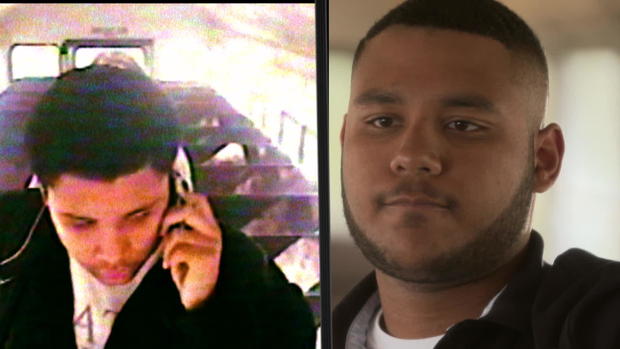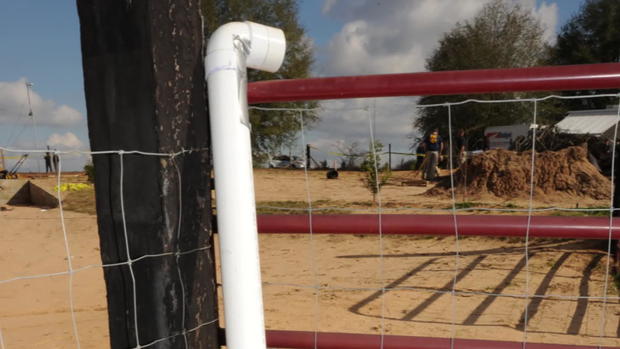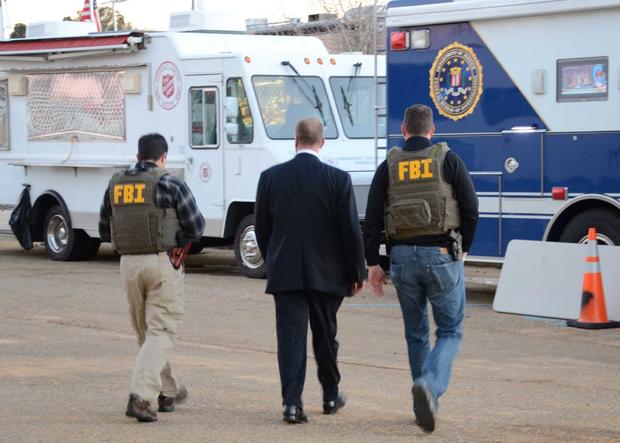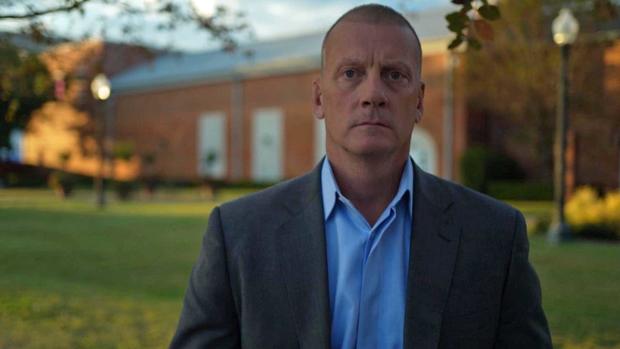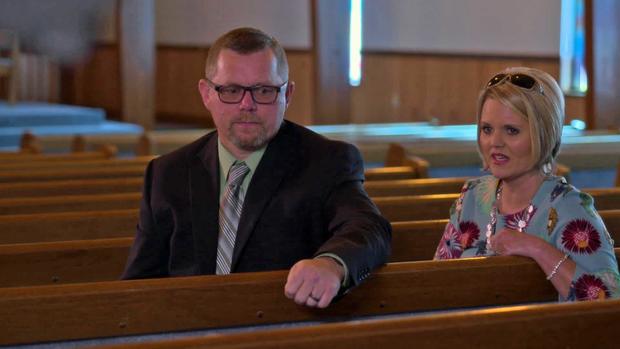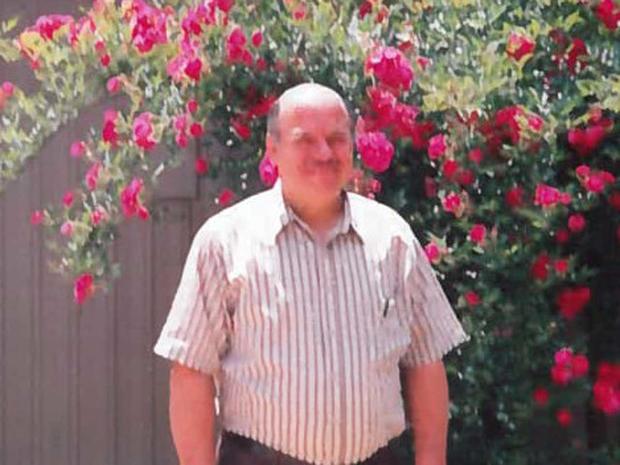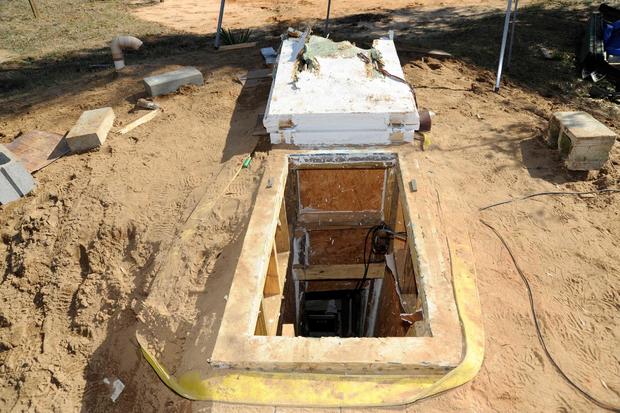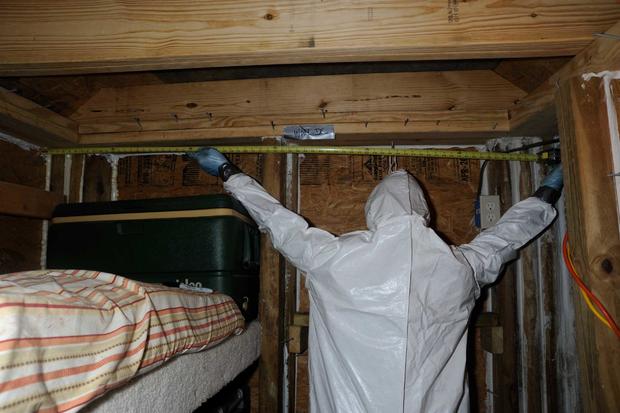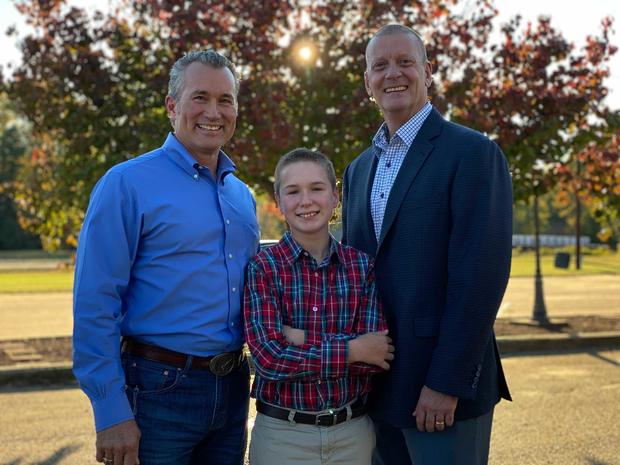Saving Ethan: The FBI’s race against the clock to rescue kidnapped Alabama boy
Through never-before-seen footage and in-depth interviews, “The FBI Declassified” takes you inside the minds of heroic federal agents and analysts as they reveal how they solved some of the biggest cases of their careers. Watch Tuesdays at 10/9c on CBS.
Produced by Caroline Sommers
In January 2013, an armed man jumped on a school bus packed with children in Midland City, Alabama. Jimmy Lee Dykes shot and killed the driver and kidnapped 5-year-old Ethan Gilman and took him to a heavily fortified underground bunker. In a race against time, FBI hostage negotiators and members of the elite FBI hostage rescue team recount their elaborate plan to breach the bunker and rescue Ethan.
Steve Richardson | Former FBI Special Agent: Kidnappings are incredibly difficult for a number of different reasons. … There’s a child’s life at stake. … Emotions are high. … Time is of the essence. … My name is Steve Richardson. I was the special agent in charge.
Molly Amman | FBI Profiler: When the entire FBI machine spins up on one case acting in concert, it takes your breath away. … I’m Molly Amman. I’m an FBI profiler. …There was no mountain that the FBI would not have moved to save Ethan.
911 OPERATOR: 911, where’s your emergency?
TRÉ WATTS: Um, I don’t know we’re on the bus and someone is trying to take our kids.
911 OPERATOR: Somebody on the bus was trying to take your kid?
TRÉ WATTS: Yes, ma’am.
Dale County Sheriff’s Office/CBS News
Tré Watts: My name is Tré Watts. And I was on the bus that day when I called 911. … It was a normal day, just like any other.
Tré Watts: I usually sat in the third seat from the back.
Tré Watts: We’re dropping off the kids and I feel a big lurch on the bus. And I look up and I notice a guy is on the bus and he has a gun pointed at Mr. Poland’s head.
Steve Richardson: If my children were on a school bus, I would want someone like Charles Poland defending them. He said,” You can’t do this. … I will not let you take the children.”
Kevin Cornelius | Former commander, FBI Hostage Rescue Team: He was asking for two kids … that are … certain ages … he was asking for children to come forward.
Tré Watts: He just kept saying over and over,” I need the kids, I need the kids, I need the kids.”
JIM DYKES [School bus surveillance video]: I need two kids. Two boys.
JIM DYKES: They will not be harmed. You won’t be harmed.
CHARLES POLAND: It’s my responsibility –
JIM DYKES: I can’t help that
CHARLES POLAND: — to keep these kids on the bus…
JIM DYKES: I can’t help that. I can’t help that.
CHARLES POLAND: I can’t turn them over to somebody else.
Steve Richardson: Every time I listen to his … dialogue … cold chills run up my spine.
Kevin Cornelius: The majority of the kids ran to the back. And even as he was in there and he was talking to Mr. Poland, he was making his demands, kids would come out of a seat and they would go two or three seats back.
JIM DYKES [School bus surveillance video]: I’m gonna have to shoot you now. Come on, I don’t have any time, the god***n law’s comin’. Come on! Don’t! Don’t!
Tré Watts: And at that point, Mr. Poland proceeds to try to pull off. … The guy pulls the gun out and says, “Pow, pow, pow.”
911 OPERATOR: What’s going on?
TRÉ WATTS: The bus driver’s dead.
911 OPERATOR: He what?
TRÉ WATTS: The bus driver’s dead.
Tré Watts: And at that point… he took Ethan off the bus.
JIM DYKES [School bus surveillance video, kids crying] Come here! Come here! Come here!
Steve Richardson: Little Ethan was sitting on the first seat behind Chuck Poland.
Kevin Cornelius: Ethan was just … stunned.
FBI
NEWS REPORT: We understand the man is holding that child in a bunker on his property.
911 OPERATOR: OK, what’s your name sir?
JIM DYKES: Jim Dykes.
Steve Richardson: He introduced himself – but it was cut short.
JIM DYKES: I’m in a underground bunker.
911 OPERATOR: You’re in an underground bunker? OK sir, you have a child with you?
JIM DYKES: Yes.
Steve Richardson: The bunker – was … 6 by 8 by 12 feet straight down. … The way that he had constructed the bunker, he was very proud of his project.
Kevin Cornelius: There’s a lot of options that the Hostage Rescue Team practices on a daily basis … not necessarily a bunker that’s 12 feet down in the ground. … I’m Kevin Cornelius, commander of the hostage rescue team.
911 OPERATOR: Attention all units, be advised, I have suspect on 911 … is armed, does have the child hostage, he’s in a underground bunker… Sir? Sir, is the child harmed? … Hello? … I just lost the guy…
Steve Richardson: He called back and gave very specific instructions to law enforcement.
JIM DYKES TO 911: When the cops get here, they can talk to me … they stop at the front gate.
Steve Richardson: The ironic thing is, is he was incredibly winded. … So, I know Ethan was fighting him.
JIM DYKES TO 911: They can stop there and talk to a white post, a white PVC pipe sticking up.
Steve Richardson: He talked about a talking tube down by the gate … and said that he was no longer going to communicate via cell phone. … The only way he would communicate with law enforcement was via that speaking tube.
FBI
Kevin Cornelius [at bunker]: As I recall, the PVC pipe that was the talking tube was 170 feet from just outside the gate to where the bunker is back here. … And it was just kind of like a string and a can. You would be able to talk from one end to the other and be able to hear the voice.
Steve Richardson: It was all orchestrated. It was all part of his master plan. … According to him, he had a story to tell.
Molly Amman: We did not know the nature of the story, only that he thought that once the public became aware of his story, there would be riots in the street and potentially a revolution of some sort.
Steve Richardson: It became very clear that Ethan was … a pawn for Dykes to carry out his very well-orchestrated plan, at least in his mind.
NEWS REPORT: Negotiators are trying to talk with the suspect and the boy.
Steve Richardson: We had a hostage situation active, live. We had a murder. … We had a bad guy that was incredibly unpredictable.
Steve Richardson [at bunker]: He had planned this out for months and months and months, and he was going to execute his plan – regardless of what happened.
DAY 1
For seven days beginning in January 2013, hundreds of law enforcement agents were focused on rescuing Ethan Gilman. The 5-year-old kindergartner was held hostage in an underground bunker in rural Alabama by Jimmy Lee Dykes.
Bill Rafferty of the Houston County Sheriff’s Department was among the first to arrive.
Bill Rafferty: We pulled up and parked on 231 — at the entrance to the dirt road here, exited the vehicle and came up here.
Bill Rafferty: Right here in this area was a 6 foot by 8 foot bunker underground.
FBI
Authorities quickly realized this was a time-sensitive situation and called in the FBI.
Steve Richardson: I was taking care of some of those normal routine tasks that came my way and one of our bomb technicians came up … he said, “Boss, we’ve got a problem.”
At the time, Steve Richardson ran the FBI field office in Mobile, Alabama.
Steve Richardson: We started deploying all the assets that we had based upon the information that was available to help solve the problem.
Deputies soon learned that Jimmy Lee Dykes and the man he had just brutally murdered, bus driver Charles Poland, knew each other. Every school day, Poland would drive the bus up the private road where Dykes lived. After dropping kids off, Poland had to make a U-turn to go back down the hill.
Sheriff Wally Olson | Dale County, Alabama: He befriended Mr. Poland. … He’d actually dug out an area for the bus to be able to turn around.
But investigators say Dykes wasn’t doing this to be helpful. He had an ulterior motive: to get on Charles Poland’s bus, take hostages, and use them as pawns in a twisted effort to share his grievances with the world.
Dykes was no stranger to law enforcement. A deputy recorded a confrontation between Dykes and a neighbor two years earlier — a dispute over the nuts from a pecan tree:
JIM DYKES | November 16, 2011 recording]: I mean he’s an absolute – he’s an absolute idiot. … What if they’re growin’ bananas there, you can’t pick up bananas either there, could ya.
With Jimmy Lee Dykes, even the simplest spat could trigger a tirade.
JIM DYKES [November 16, 2011 recording]: Republicans, Democrats, they’re all the same to me, they’re all crooks …
Steve Richardson: We had some information early on … that he had some anti-government ideals.
Bill Rafferty: He appeared to hate everything — the government, the way things are done, the laws.
In fact, Dykes had a scheduled court appearance the day after he took Ethan hostage to answer charges related to pointing a gun at another neighbor.
Bill Rafferty: My understanding, once that he gotten in trouble this last time, he started working day and night to complete the bunker.
Bill Rafferty: I feel that he planned this whole ordeal … because of … his not wanting to go to court, his not believing in the court, not believing in … that he even committed a crime.
Bill Rafferty: The pipe … had an elbow on it. So you weren’t trying to talk down into it but you talking to it and it was facing this way and this is where we were originally talking to him at.
Bill Rafferty: It was amazing how clear you could hear Mr. Dykes speak and apparently he could hear us quite well, too.
JIM DYKES [negotiation audio]: The politicians, they don’t care — they pass laws to get votes.
Bill Rafferty: I start talking with Dykes. … We were listening to what he was saying … but we were also, every chance we got, trying to give him a way out.
BILL RAFFERTY [negotiation audio]: I’m listening. … You don’t want me to, but I’m fightin’ for you just like I am Ethan.
Ethan had started riding the bus to school just that year. Investigators would learn he came from a troubled home and had behavioral issues.
Bill Rafferty: Ethan’s background and his lifestyle I think he had been around a lot of … strangers.
Investigators hoped that experience with strangers would help Ethan in the bunker with Dykes.
BILL RAFFERTY [negotiation audio]: I want you to come out with Ethan and tell your story, that’s what I want.
Steve Richardson: Our negotiators were very familiar with Bill. He spent … multiple weeks at Quantico training to be a certified hostage negotiator. From the FBI standpoint, that training is not easy.
JIM DYKES [negotiation audio]: Unless you need me, just give me a call.
Bill Rafferty: When Dykes stated that he was done talking for the night, he wasn’t talking no more, we were escorted back to the church.
A quarter mile down the hill from the bunker, Destiny church became ground zero for the FBI’s operation.
Bill Rafferty: I was informed at that point that I needed to be there the next day. … They were going to put an agent — talking with Dykes … but wanted me to be there as the coach.
FBI
As day turned to night, Special Agent in Charge Steve Richardson sent his team out to gather whatever intel they could.
Steve Richardson Our technically trained agents had gone up in the middle of the night … trying to gain access to that tube to see what they could do in order to give us any type of visibility into that bunker.
What they discovered was alarming: a homemade bomb at the base of the talking tube, outside the bunker.
Steve Richardson: We couldn’t predict what he was going to do next … There was one thing in mind and that was to get the little guy out of the hole as safely and as quickly as possible. Nothing more, nothing less.
DAY 2
When the FBI discovered that Jimmy Lee Dykes had rigged a bomb at the base of the talking tube outside his bunker, the crisis escalated.
Steve Richardson: It became very clear to me, very quickly, that although we have some very, very good, specialty skill sets within the Mobile division, we needed help-and we needed a lot of help.
Richardson requested assistance from headquarters. They sent profilers from the FBI’s Behavioral Analysis Unit and its elite hostage rescue team.
Kevin Cornelius: The first order of business when you get to a site like that or to an incident as a hostage rescue group, you want to put in place an emergency hostage rescue plan.
Molly Amman: The first time I’d heard of this was when my phone rang at or after 11 p.m. at night. I was asleep in my bed, not uncommon for our phones to ring and wake us in the night, if we are needed, we are there.
Negotiators had been talking to Dykes through that booby-trapped pipe — but now it was far too dangerous. Afraid it would detonate, the FBI needed a safer way for them to communicate.
Steve Richardson [at bunker site]: Day two, the technically trained agents along with the electronic technicians, the ET’s, made a PA system and set it right here, so —
Kevin Cornelius: — speaker box.
Steve Richardson: Yeah. We were talking to him –
Kevin Cornelius: Right.
Steve Richardson: – and he’d known none the different than that we weren’t standing right there.
Kevin Cornelius: Right –
Steve Richardson: So, that probably pacified him a little bit.
Kevin Cornelius: And I think, so after that then we actually got the throw phone in.
Steve Richardson: That’s right.
CBS News
Agents delivered a throw phone to Dykes through the hatch he’d designed as an entrance. He could use it only to talk to law enforcement.
Steve Richardson: He accepted a phone that the negotiators used and were able to talk to him very clearly. And that benefited both him and our negotiators.
With that direct line to negotiators – some of which was recorded – Jimmy Lee Dykes laid out what he wanted.
JIM DYKES [negotiation audio]: The message has got to be out there before I die.
Steve Richardson: His original demands were to have … a reporter come down into the hole. He wanted to go live on TV —
Molly Amman: Once the reporter, a female reporter, was down with him, his vision was that she would hold his hand while he shared this story with her for her to broadcast to the world and then he would suicide — and she would be able to let herself out of the bunker.
JIM DYKES [negotiation audio]: There’s no way I’m walking out of here in other words is what I’m sayin.
BILL RAFFERTY: I hear what you’re saying.
As Dykes pushed to air a long list of complaints about the government to a live tv audience, FBI profilers worked hard to analyze him. Negotiators tried to keep him calm.
Steve Richardson: Negotiation is a conversation. And during that conversation, you as a negotiator are trying to get the bad guy to talk. … You’re gathering information that might be useful down the road, good or bad.
BILL RAFFERTY [negotiation audio]: We wanna be able to get to that point where you can get your story out and where it will go on, where it won’t die. Where your message keeps going. And we want Ethan safe.
JIM DYKES: OK.
BILL RAFFERTY: And I want to look for any way we can do to get there.
Molly Amman: If I could summarize our mission … it would be to hopefully bend Jim Dykes to our will. That was what we wanted to do, we wanted him to release Ethan. And persuading him to do that was everything.
CBS News
Molly Amman FBI agents and other law enforcement professionals all over were gathering information about him and that was critical to my understanding. I was beginning to develop a picture of Jim Dykes as an injustice collector.
JIM DYKES [negotiation audio]: I can’t trust anyone … you can’t trust anyone in this society to do anything unless it’s beneficial to them.
Steve Richardson: He fancied himself a victim. He was playing the victim card, he had — anything and everything bad that had ever happened to him in his life was someone else’s fault.
Molly Amman: I don’t think he realized necessarily that we were trying to get into his head. I think that he was so focused on his own mission, nothing else existed.
NEWS REPORT: We are continuing to follow a hostage situation that is now reaching its third day.
Making the situation even more complex was Ethan’s need for medication for those behavioral issues. Dykes agreed to have it delivered. Four times a day, the SWAT team would drop the medication through the bunker hatch.
CBS News
Kevin Cornelius [at bunker]: Whenever we would make the delivery, you would only get maybe 4 inches to 8 inches of visibility into the hatch.
Kevin Cornelius: So, as the medicine drops were coming in, it gave us an opportunity to learn more about the bunker itself.
Agents managed to sneak a camera into the bunker, which gave them valuable information. They saw beds, a TV, snacks and water. For FBI profiler Molly Amman, it was a psychological puzzle – with two players.
Molly Amman: We were spending a lot of time analyzing Jim Dykes, but not just Jim Dykes. It was very important for us to understand his hostage. … Really, the two of them were sort of orbiting each other in a co-dependency.
Molly Amman: Jim Dykes needed Ethan because Ethan was his only protection against assault on his position and he knew that. Ethan needed Jim Dykes because he was the difference between life and death for Ethan. … He was providing him food, water, medications, toys.
Steve Richardson: Early indications were that he may have had some type of empathy for Ethan. He may have cared for him in some way.
JIM DYKES [negotiation audio]: Look, uh, isn’t this, isn’t this child supposed to get some more medicine tonight?
NEGOTIATOR: Yeah, at 7:00. It’s only 6:00.
Molly Amman: The reality was that Jim Dykes had a whole life pattern of low to no empathy for other human beings and for him to suddenly care for Ethan in an emotional way rather than a practical, utilitarian way … that would be a, such a dramatic break in his life pattern.
While law enforcement was working around the clock, the community was coming out in force to pray for a peaceful resolution.
WTVY NEWS REPORT: Vigils have been scheduled all across the Wiregrass … They found a backpack on the ground with the name Ethan on it.
Pastor Brandon Turner: At first, all I knew about was called a boy in the bunker. You know, it’s just kind of the way they said it. I didn’t even know his name or anything at first, we were just praying for a kid that we knew had got kidnapped off a bus.
But once Ethan’s name was on the news – Pastor Brandon Turner and his wife Nicci had a heart-stopping realization.
Nicci Turner: I just had this sick feeling. That it was our Ethan.
CBS News
Because of his unstable upbringing, Ethan had been in and out of foster care most of his life, including a short stay with the Turners when he was just a toddler.
Pastor Brandon Turner: He was a little bitty squirt when we had him … and so, man, it just broke our heart. My oldest son still had a picture of him in his wallet. He’d got that attached to him.
Nicci Turner: Of when he was a baby, when we had him.
Pastor Brandon Turner: You pray, and you hope for the best. But, it — the more it went on and the more they described, it didn’t sound like it was going to be good.
Molly Amman: Jim Dykes was profoundly rigid, fixed on his plan, unable to see alternatives … I knew Jim Dykes to be someone who saw violence as a necessary consequence to others. … I absolutely believe that he was capable of killing Ethan.
DAY 4
NEWS REPORT: The suspect is still barricaded inside that underground bunker.
Steve Richardson | Former FBI Special Agent in Charge: It’s a bit of a blur. … I spent 17, 18 hours a day here.
Kevin Cornelius | Former commander, FBI Hostage Rescue Team: For a while, everybody can stay up for maybe for … 24 hours to 48, but at some point you’re gonna have to start getting some rest, so you can continue to make those good decisions.
Steve Richardson: Who could go back to bed and sleep with all this going on? I wanted to continue to work, to think … to help us solve the problem.
The problems just kept mounting. The hidden camera agents managed to sneak in revealed that Dykes not only had a gun, but another homemade bomb. They could also see Dykes was watching TV.
RONDA BRUSIUS [2013 news report]: This guy is gonna snap. … This guy is an accident waiting to happen.
Steve Richardson: We were a little bit concerned when the neighbor got on TV and described a scenario in which Dykes had killed her dog.
RONDA BRUSIUS [2013 news report]: He beat the dog until he thought that the dog was dead.
Steve Richardson: We thought that that might make Dykes mad, would inflame him again, would irritate him that someone was spreading negative information about him. If you recall he was a victim of everything–it wasn’t his fault, it was the dog’s fault.
To try and keep Dykes calm, the FBI came up with what might seem like an unusual plan.
Steve Richardson: The only government official, from an enforcement standpoint, that he would have any respect for or recognize was the elected sheriff in the county from which he resided. So, we used that to our advantage.
Molly Amman: And, so, what we asked Sheriff Olson to do was to publicly thank Jim Dykes for taking care of Ethan.
SHERIFF WALLY OLSON [Day 5, to reporters]: Mr. Dykes … told us … that he’s taking care of him. … He’s also allowed us to provide coloring books, medication, toys … I wanna thank him for taking care of our child.
Sheriff Wally Olsen | Dale County, Alabama: I knew that people would look at me and say, “Why are you sayin that?” You know, but at the same time, I had to stay focused on what we were trying to do.
Molly Amman | FBI Profiler: Certainly counterintuitive, perhaps, to consider a message like that. But we really wanted Jim Dykes to see himself as a hero to Ethan, as a good guy … and to help him resist any urge that he may be feeling to harm Ethan.
BILL RAFFERTY [negotiation audio]: He’s gonna remember you, he’s gonna remember how nice you were to him, how caring and lovable you were to him.
Molly Amman: We needed Jim Dykes to see Ethan in human terms, in compassionate terms … And that messaging was one of our strategies to try to achieve that.
BILL RAFFERTY [negotiation audio]: You make sure that he’s safe. Please make sure he’s safe.
JIM DYKES: I’m going to.
Bill Rafferty: While we were dealing with Dykes, you know, people behind the lines were doing a lot of other things. There was the Seabees brought in … and they built a mock bunker.
The Seabees are the Navy’s construction battalion.
Kevin Cornelius: These guys can build anything. They are absolutely amazing. … We gave them all the that dimensions that we had, at that point we had ground-penetrating radar data. … And behind the staging area of the Hostage Rescue Team … the Seabees built a full mock-up … that we could train in.
The FBI also wanted to build a replica of the IED bomb Dykes had in the bunker — and test its force. The device was located near a propane tank. Specialists knew exactly what materials to use: agents had retrieved receipts from his garbage.
Kevin Cornelius: It was … right in front of the mobile home that was sitting there. It was a trailer.
Steve Richardson: Oh, yeah, right. I’d forgotten. That’s right.
Kevin Cornelius: That was actually the receipts of all the stuff that he bought to build the bomb- both bombs.
Steve Richardson: Yes.
FBI bomb specialists were able to duplicate the explosive.
Kevin Cornelius: And they fired it off, you know, on a demolitions range back at Quantico, Virginia. And it was devastating.
Kevin Cornelius: I think his hopes … were that the propane tank would be an accelerant, that it would cause some type of ball of fire. Instead, what it turned it into was a projectile. … Could maim, damage, kill … anybody in its path.
Pastor Brandon Turner: We all got together in a joint effort to pray. And we actually had members that tried to go as close as they could get over there to pray for him and see if there’s anything they can do.
Nicci Turner: We prayed really hard, you know, for him the whole time he was down there.
Molly Amman: As the days wore on, Jim Dykes became tired. … And he began to exhibit less patience with Ethan, a shorter temper even than he had previously with negotiators.
Molly Amman: The relationship between Jim Dykes and Ethan was evolving, of course, over time. It was of tremendous concern to us; a bond of an unclear nature was forming between them.
Bill Rafferty: Ethan told Dykes that he loved him. And that sent Dykes into a — he was — upset him very bad. … Dykes was on a mission … it did not include having affection from a victim that he kidnapped.
Bill Rafferty: He would be way, way up here. And we would get him down and get him down and get him down. But we never could bring him down to reality.
Steve Richardson: The first incident where it became incredibly intense was, we were making a medicine delivery, we were trying to film part of that, he saw the camera at one point and became incredibly irritated.
Steve Richardson: Another incident, we came up and we were delivering medicine again. … Dykes saw the muzzle end — the business end of an M4 — and he became incredibly irritated again.
Bill Rafferty: And he indicated that we were trying to kill him at that point. That is when Dykes broke down. … Very upset, crying. … That was a key factor that took him to a place we never
JIM DYKES [negotiation audio]: I want you to know that trigger-happy son-of-a-bitch, he may thinks he’s Rambo, and he may thinks he’s gonna be a hero if he does that, but he ain’t gonna be no god***n hero when the world knows he’s responsible for killing this kid.
DAY 6
Steve Richardson: On day six, Dykes started making very specific demands. He was incredibly agitated.
The FBI believed Jimmy Lee Dykes was upset because the phone they gave him allowed him to communicate only with negotiators. He wanted another phone so that he could directly speak to reporters covering the story. And he wasn’t getting his way.
JIM DYKES [negotiation audio] : I can call CNN, I can call every damn body possible.
Bill Rafferty: Everything started deteriorating with him as far as communications. And on Sunday is when he basically give us the deadline, if we didn’t have him … a hardline phone in there by 5:30 Monday afternoon that … he was cutting off all communications with us.
Molly Amman: Up until that point, one of the negotiators’ most reliable topics to defuse an angry situation was to ask about Ethan. Very often, Dykes would disengage from his rant and go check on Ethan and come back into the phone and report whatever Ethan was doing.
BILL RAFFERTY [negotiation audio]: Are you ready for Ethan’s meds? He’s —
JIM DYKES: No, what the f**k’s going on about the phone?
Molly Amman: When even that began to disappear from his behavioral set, that raised concerns for us that potentially time was running out.
Pastor Brandon Turner: We didn’t know what was going to happen. [pauses] You know, it’s scary because we’d never had anything like that happen around here.
As hundreds of law enforcement officers devised a plan to rescue Ethan, the community mourned Charles Poland, the beloved bus driver Dykes murdered.
Lydia Hancock
Lydia Hancock | Charles Poland’s daughter: Daddy was a lot of things in the 66 years he was here on this Earth. … He was a brother, a son … a daddy … a husband … the grandfather, Paw Paw … everybody just, he was a funny, lovable, caring, just — I mean, there’s not another person like him.
Steve Richardson: Chuck Poland felt bad for Dykes. … Mr. Poland was smart enough to know that he didn’t have any friends and probably knew his reputation.
Lydia Hancock: Daddy had given him a jar of jelly and a dozen of eggs that morning.
Steve Richardson: So, he was trying to help a neighbor, like most everyone would do in this particular community, try to help one another out in need. And this was Dykes’ repayment.
Molly Amman: It became clear that Jim Dykes was isolated. He had no tethers of emotion to friends, to family. … And, so, one of my challenges was to come up with a strategy to help him overcome that. And the ideal would be for him to want to bond with someone outside the bunker.
Agents believed finding such a person was their best hope of saving Ethan — and getting Dykes to surrender. They learned Dykes had two daughters and he hadn’t seen them in years.
Steve Richardson: And one of the daughters agreed to come here and if needed, have a conversation with him if it would help save the child.
Cindy Dykes told the Wall Street Journal about her conversation with the FBI:
CINDY DYKES: They asked when the last time I had talked to him and I told them I hadn’t had any, I hadn’t seen or heard from him since I was 10 or 11 … And I told them whatever they needed. I have a little boy the same age.
As agents spent the weekend prepping his daughter, Dykes spun further out of control, even taunting the agents.
JIM DYKES [negotiation audio]: You just go ahead and send some mother****r down that god***n uh, funnel up there to their death.
Molly Amman: Jim Dykes had a mission, that mission was failing. He was not given the reporter down in the bunker. He was not given a platform to speak to the media and air his story to the world, nothing was working out the way he wanted it to.
DAY 7
Bill Rafferty: Going into Monday … he went on a very long rant.
JIM DYKES [negotiation audio]: You know god***n well I’m smarter than most of you f*****g people. …I have the experience; I have the ability and I have the balls to show just how f*****g corrupt this god***n system is.
Steve Richardson: And uh, if his demands were not met … he was gonna blow himself and Ethan up.
Molly Amman: Jim Dykes began handling his firearm, which we felt were rehearsing behaviors, prior to potentially setting off the improvised explosive device he had in the bunker.
Kevin Cornelius: He talked about teaching Ethan how to set off the IED inside.
Molly Amman: Nothing good was happening. I certainly was profoundly alarmed for Ethan’s safety, as I think we all were.
Kevin Cornelius: And I think that all led to a decision point.
After a week of failed negotiations, it was time for drastic action. The team ran a plan by then-FBI director Robert Mueller and his top brass. They’d been following the situation all week.
Kevin Cornelius: And it was during that call with Director Mueller … that we went over, it seemed, like everything that we had done since Day 1 to make sure that we didn’t miss anything.
Molly Amman: And what I told the director was that Jim Dykes … was taking care of Ethan’s physical needs, yes he was feeding him, yes he was giving him toys, yes he was giving him his medications, but it would be a grave error in my judgment to, from that, assume that somehow Ethan was safe in Jim Dykes’s care.
Shelly Linderman
Steve Richardson: We had expressed to them that … this was not going to end well unless we — we did something.
That’s where Dykes’s daughter came in. The FBI planned to set up a computer video chat between the two.
Molly Amman: He even asked for a comb to comb his hair. He asked for a clean shirt. He wanted himself and Ethan to be presentable for that encounter.
FBI headquarters gave the hostage rescue team the green light to move in only if the opportunity presented itself.
Steve Richardson: Ethan had to be in a safe space. He had to be out of sight, away from the shaft of the bunker. Dykes had to come up the ladder and receive a computer.
Molly Amman: I wanted this to be the moment that turned things around, I wanted to believe that … this opportunity to reconnect with his daughter could be a game changer for us. But it wasn’t.
GO TIME
Kevin Cornelius: How could we get Dykes in a position and ensure that Ethan was in a position that we could carry out an effective hostage rescue?
After Jimmy Lee Dykes accepted a computer for a video chat with his daughter, the FBI was able to see that Ethan was far enough away from Dykes to initiate its rescue plan.
Steve Richardson: We were staged, ready to go, and the criteria that had to be met were met, and the execute order was given.
Kevin Cornelius: We were in the command post — we had a live … video feed from the surveillance reconnaissance aircraft that we had in front of us.
Steve Richardson: It was very quiet in the command post, somber. … I called my wife and said, “I can’t tell you why, but I’m asking you to pray. For the safety of our people and the safety of Ethan.”
Kevin Cornelius: All of this in my mind was gonna take seven seconds– at least if everything went right.
This was the moment hostage rescue team members, known as operators, had been preparing for all week. It was go time. They blew the hatch open.
Steve Richardson: I watched the first operator approach the bunker. He jumped in, as we all knew that he would. And then I saw the second operator go behind him and he tried to jump in and couldn’t and I immediately knew that there was a problem.
Dykes had set a booby trap: a snake pit of cables blocking the way into the bunker. Making matters worse, he started shooting at the operators.
FBI
Steve Richardson: It’s like shooting fish in a barrel … he had cover at the bottom of the bunker … and he’s firing as fast as he can at our guys.
Kevin Cornelius: How the #1 operator was not hit, I’m not sure. … But they were able to pull the #1 operator back up, obviously … speed, surprise, violence of action is what we’re looking for in a hostage rescue, so we needed to regain surprise at some point.
Moments later they threw in stun grenades. This would temporarily disorient Dykes and give hostage rescue team specialists, known as breachers, time to clear the cables. In the midst of the chaos, Dykes triggered that bomb outside the talking tube.
Steve Richardson: It backfilled the bunker with smoke. So, the visibility was next to zero.
Kevin Cornelius: There was a long silence as the cable cutting was going on. Really didn’t know what was happening, I saw people reaching down into the hole, I saw a lot of activity that was going on around the bunker itself, and I heard the team leader at the time say, um, [emotional] “Gentlemen,” – about this calm – “Gentlemen, we have to get in this hole. This is what we do.” And it was shortly after that that I saw the #1 operator jump back into the hole.
Kevin Cornelius: He got to the bottom, he turned to the left, immediately felt Ethan, and covered Ethan up, with his body. Right behind him the #2 operator and the #3 operator, um, engaged Mr. Dykes.
Steve Richardson: The message came back that the bad guy’s down. I think it, uh, the terminology was “He’s down hard.” I’m a former SWAT guy, so I understand what that means.
Kevin Cornelius: There was a struggle … and Mr. Dykes was killed in the process.
Now all attention turned to Ethan.
Steve Richardson: We don’t know if Ethan is safe or if he’s not.
Kevin Cornelius: I recall the team leader saying, “He’s cryin.”
Steve Richardson: If the little guy is crying, he’s breathing. And if he’s breathing, we got a chance. … And shortly thereafter, out of the smoke-filled hole — pops a red object with blonde hair — and it’s the little guy.
FBI
Steve Richardson: When we saw him come out, there was still silence until we saw that he was moving. And then there was — elation for just a quick point in time. But then the focus went right back to … making sure that our people were okay.
Kevin Cornelius: I’m just thankful. [emotional] … Thankful for the whole machine that put this in place that we could rescue Ethan.
After the rescue, Ethan briefly lived with his birth mother. But again, social services deemed his home life unstable. That’s when the Turner family got a surprise phone call.
Nicci Turner: The same social worker that was involved with this case the very first time gave me a call. …And she said, um, “Well, I got some news for you.” And I was like “what’s that?” And she said,” Ethan is back in the system.” … I was like … it feels like he’s mine anyway. I said, so, “of course.” So, he came, and he didn’t even leave.
Ethan is now 13 years old and thriving. He has nine brothers and sisters, all adopted by the Turners. He rarely talks about being held hostage, but he does remember some details.
Ethan: It all happened in a split second. … I seen this thing coming from the door. It went da da da da and then smoke.
Nicci Turner: Could you see anything?
Ethan: Think I seen the bullet and then the smoke and then the door opened. That’s when it all got quiet.
Kevin Cornelius: Brings back some memories for sure.
Steve Richardson: Yeah, it was odd driving up.
Seven years have passed since the rescue. The agents had thought about Ethan, but not seen him until a surprise reunion in the church parking lot — the one-time command center.
Kevin Cornelius: Hey buddy!
Whitney Catandella
Steve Richardson: Hey buddy! You know what? You don’t remember us, but we sure remember you. Right? How are ya? Good? Well you look good! You look a lot better than you did – and looked good when I saw you last, but you look really, really good now.
Kevin Cornelius: Many of the guys on the team, Steve, myself, Wally, we all have families … at some point you have to divorce yourself from that. At the time, I don’t think that I felt the emotions that I feel today when I look back on it.
Sheriff Wally Olson [driving]: This section right here has been named the Charles Poland Memorial Highway, you know, after Mr. Poland … what he sacrificed.
Steve Richardson: On that particular day, the most innocent form of human nature came in contact with the most evil form of human nature. And there was a conflict. … But ultimately because of the perseverance, the dedication and the hard work of everyone involved … a life was saved. … The child is with us today … and what a blessing.

